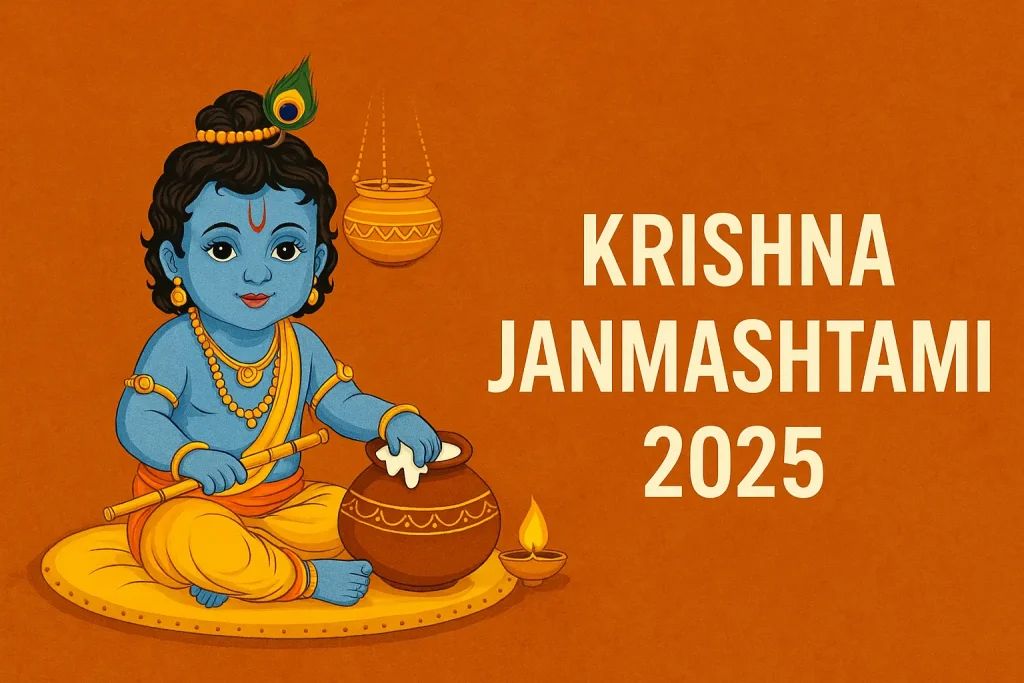 Image Source: Ai Astrologer
Image Source: Ai Astrologer
Krishna Janmashtami, one of the most revered and joyous Hindu festivals, commemorates the birth of Lord Krishna, the eighth incarnation of Lord Vishnu, celebrated with fervor and devotion across India and worldwide. Marking the 5252nd birth anniversary of Krishna, this festival in 2025 will be observed with special significance as it coincides closely with India's Independence Day, bringing together spirituality and celebration.
Date and Significance
Krishna Janmashtami 2025 falls on Friday, August 15, with key rituals unfolding at midnight, the precise moment believed to be the time of Lord Krishna's birth. The celebration extends into the early hours of Saturday, August 16, with various festivities, prayers, and cultural events. The festival takes place on the eighth day (Ashtami) of Krishna Paksha (the dark fortnight) in the lunar month of Bhadrapada, coinciding with the auspicious Rohini Nakshatra, underlining its celestial importance.
Auspicious Puja Timings and Muhurat
The most sacred part of Janmashtami is the Nishita Puja (Midnight Puja), signifying the exact time of Krishna's birth. In 2025, this will be observed across cities roughly between 12:04 AM and 1:06 AM on August 16, with timings varying slightly by location:
New Delhi: 12:04 AM to 12:47 AM
Mumbai: 12:20 AM to 1:05 AM
Ahmedabad: 12:22 AM to 1:06 AM
Bengaluru: 12:01 AM to 12:47 AM
Chennai: 11:51 PM to 12:36 AM
Kolkata: 11:19 PM to 12:03 AM (extending into August 17)
Pune: 12:17 AM to 1:02 AM
Jaipur: 12:10 AM to 12:53 AM
Hyderabad: 11:58 PM to 12:43 AM
Gurugram: 12:05 AM to 12:48 AM
Chandigarh: 12:06 AM to 12:49 AM
Noida: 12:03 AM to 12:47 AM
The precise timing of the puja ensures rituals align with divine celestial movements and heightens the spirituality of celebrations. The Ashtami Tithi (the eighth lunar day) begins late on August 15, continuing through much of August 16.
Key Rituals and Observances
Devotees engage in a day-long fast, vigil, and elaborate worship rituals culminating in the midnight puja and celebrations. The rituals embody devotion and embody various traditional practices:
Purification and Decoration: Homes and temples are thoroughly cleansed and decorated with flowers, rangoli (colourful floor art), lights, and ornate cradles for baby Krishna (Laddu Gopal).
Idol Bathing and Dressing: The idol or image of baby Krishna is bathed in panchamrit—a sacred mixture of milk, curd, honey, ghee, and sugar—followed by clean water. The deity is then dressed in new clothes and adorned with jewellery, peacock feathers, and flower garlands.
Offerings and Bhog: Devotees present butter, fruits, sweets like panjiri and laddoos, tulsi leaves, and other traditional items as offerings, sharing prasad (blessed food) after rituals.
Midnight Celebrations: The Nishita Puja includes singing devotional bhajans and kirtans, and ceremonially swinging the cradle while chanting prayers, symbolizing joy at Krishna's birth.
Fasting and Vigil: Many devotees observe rigorous fasts, breaking them only after the completion of midnight prayers and puja rituals, typically after 9:34 PM on August 16.
Dahi Handi: Especially popular in Maharashtra and nearby states, groups form human pyramids to break a pot filled with curd hung high, reenacting Krishna's childhood pranks.
Recitation of Scriptures: Readings from the Bhagavad Gita and stories of Krishna’s heroic and divine acts strengthen the spiritual essence of the day.
City-wise Celebrations and Festive Programs
Across the country, temples and community centers organize special events:
Mathura and Vrindavan, regarded as Krishna’s birthplace and childhood home, host elaborate processions, devotional singing, and dramatic enactments of Krishna’s life stories.
In metropolitan cities like Delhi, Mumbai, and Bengaluru, cultural programs, midnight arati (worship with lamps), and fairs accompany the rituals.
Community kitchens distribute free meals and prasad to devotees, emphasizing sharing and devotion.
Special school and college holidays in many states allow families to participate fully in celebrations.
Significance and Spiritual Essence
Janmashtami symbolizes the triumph of good over evil, spiritual wisdom, and divine love. Lord Krishna’s teachings in the Bhagavad Gita continue to inspire millions. The festival rekindles collective devotion while nurturing a sense of cultural unity and historical continuity.
Conclusion
Krishna Janmashtami 2025 promises to be a vibrant and deeply spiritual celebration marked by dedicated prayers, auspicious timing, and widespread cultural festivities. Whether partaking in temple rituals, community events, or personal observances at home, devotees can immerse themselves in the joy and reverence of Lord Krishna’s birth, connecting across traditions and regions to celebrate this divine occasion.
Sources: India Today, Economic Times, News18
Advertisement
Advertisement






